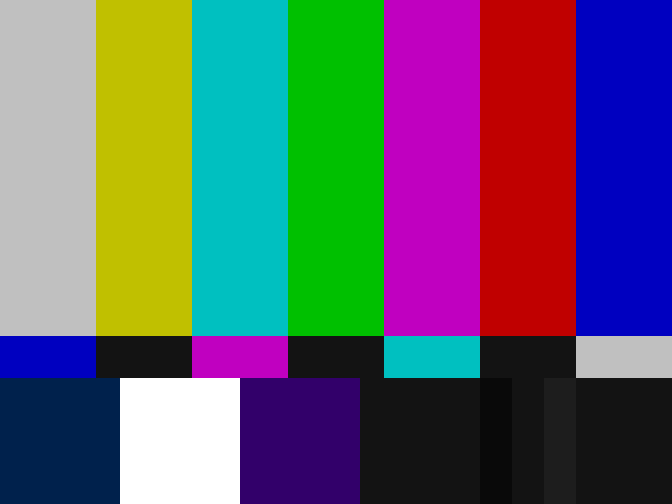 The television test screen, known as “bars and tones”, is used to calibrate color and sound on a TV screen or computer monitor. The accompanying tone—the soundtrack to this minimalist music video—is a high sharp B that stations use to tune TV’s. But at 1000 Hz, the bars-and-tones tone is a quarter-tone sharper than the closest B5 (987.77) tone. Much to the chagrin of couch-potato guitarists, the sharper tone certainly makes it difficult to tune along at home. Drag over the noteheads below to hear this sharpened B abomination that the reptilian broadcasters devised. Compare this false B to a real B5 below.
The television test screen, known as “bars and tones”, is used to calibrate color and sound on a TV screen or computer monitor. The accompanying tone—the soundtrack to this minimalist music video—is a high sharp B that stations use to tune TV’s. But at 1000 Hz, the bars-and-tones tone is a quarter-tone sharper than the closest B5 (987.77) tone. Much to the chagrin of couch-potato guitarists, the sharper tone certainly makes it difficult to tune along at home. Drag over the noteheads below to hear this sharpened B abomination that the reptilian broadcasters devised. Compare this false B to a real B5 below.
Musicians can’t catch a break in this society. Everywhere around them are false B’s. The Grid Tone is a flatted B (60 Hz)—about halfway between a B♮ and a Bb—and feeds back from their very instruments, providing them with a false note to tune to. And now TV tuning is all off too! You’d think the reptilian broadcasters would support a single tuning to unite the human race. We need to start demanding equal temperament for all peoples.
Epilogue:
 I remember an interview with Elliot Smith where he talked about watching a lot of TV while playing guitar to write songs, and I imagine it is a fairly common phenomenon for artists to work under distraction. The tube inside a television is said to emit alpha waves (among other things), that entrain your brain, lower your freqs., and put your mind at rest, so that you are an impressionable zombie ready to lap up the oozing TV set slime. Experienced mediators are said to be unhypnotizable. Perhaps, Elliot like many other stay-at-home singer-songwriters entered a meditative trance while zoning out in front of the TV, finger-plucking his guit-fiddle and whatnot, or like Steve Vai who fell asleep while noodling, and dreamed of the best possible music, only to awake to the harsh noise of day. White noisey television snow.
I remember an interview with Elliot Smith where he talked about watching a lot of TV while playing guitar to write songs, and I imagine it is a fairly common phenomenon for artists to work under distraction. The tube inside a television is said to emit alpha waves (among other things), that entrain your brain, lower your freqs., and put your mind at rest, so that you are an impressionable zombie ready to lap up the oozing TV set slime. Experienced mediators are said to be unhypnotizable. Perhaps, Elliot like many other stay-at-home singer-songwriters entered a meditative trance while zoning out in front of the TV, finger-plucking his guit-fiddle and whatnot, or like Steve Vai who fell asleep while noodling, and dreamed of the best possible music, only to awake to the harsh noise of day. White noisey television snow.



